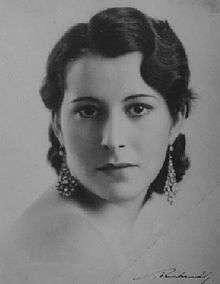Graciela Naranjo
Graciela Naranjo [nah-rahn'-ho] (December 25, 1916 – April 11, 2001) was a Venezuelan singer and actress. A radio, cinema and television pioneer in her homeland, she made her professional debut as a bolero singer in 1931. From the thirties onward her fame as a singer grew, she appeared in films and had her own TV show in an incredibly long career that extended from 1931 through 2000. She is the mother of Alberto Naranjo, a well-respected Venezuelan musician.
Graciela Naranjo | |
|---|---|
 | |
| Born | December 25, 1916 |
| Died | April 11, 2001 (aged 84) Caracas, Venezuela |
| Nationality | Venezuelan |
| Occupation | Singer and actress |
Career
Graciela Naranjo was born in Maiquetía, Vargas. Orphaned at seven, she was moved to Caracas to be raised by her aunt. She started to sing Christmas music in a church choral group at age nine, then made her professional debut at Broadcasting Caracas when she was only 15. Largely self-taught, she had a warm contralto voice as her innovative behind-the-beat phrasing and emotional intensity that she put into the words she sang, served to turn novelty tunes and light songs into definitive, bolero-based treatments. She often really did live the words she sang, particularly in later years.
From the mid-1930s through the late 1940s, Naranjo shared stages with many prestigious visiting artists from around the world, including Ary Barroso, Carlos Gardel, Tito Guízar, Agustín Lara and Pedro Vargas, to become a notorious celebrity while her audience greatly increased. She also made films in Venezuela next to Amador Bendayán and Alfredo Sadel, among other important artists, appearing in Romance aragüeño (1939), Misión atómica (1947), and A La Habana me voy (1949). She also was backed-up by the famed Orquesta Anacaona in a couple of songs which were recorded in Venezuela in 1943.
With the establishment of television in Venezuela in the early 1950s, Naranjo hosted her own TV show at the now-defunct Televisa from 1954-'55. At this time, she received contract offers from Colombia, Cuba, Mexico and Puerto Rico, but chose to stick around Caracas and raised a family instead of pursuing an international artistic career. She put off potential success until finally becoming a major TV attraction while in her 40s, retiring in 1961 in the Renny Ottolina TV show. After that, she performed on a periodic, but not regular basis, at radio, universities and nostalgia shows until the early 1980s.
Most vocalists fade while in their 60s due to the physical difficulty of their own natural instrument, but Naranjo would find herself again as a singer when she was 77. Encouraged in 1993 by her son Alberto, she started making records and returned to television and concerts. She was still active until a few months before her death, in Caracas, at the age of 84.
Graciela Naranjo was survived by her son Alberto Naranjo and her daughter Angela Mercedes Pratt; her grandchildren Grecia Garrett, Jorge Naranjo and Luis Naranjo, and great granddaughter Kai Naranjo.
Selected discography

As soloist
- Los Cantos del Corazón (1995)
- El Legado (1998)
As guest
- Cosas del Alma - Delia (1993)
- Tu bolero soy yo - Various interpreters (1998)
- Dulce y Picante - Alberto Naranjo (1998)
- Cada piano con su tema - Ignacio Izcaray (2000)
See also
- Carrusel del Pasado on YouTube - A tribute to Graciela Naranjo
- List of famous or notable Venezuelans
External links
- La Señora Bolero (Spanish)
- Venezuela Analítica (Spanish)
- Biblioteca Babab (Spanish)
- Agustín Lara – Sus más distinguidos intérpretes (Spanish)
- La historia del bolero latinoamericano (Spanish)
- Tal Cual (obituario) (Spanish)
- The Dead Stars Club (obituary)